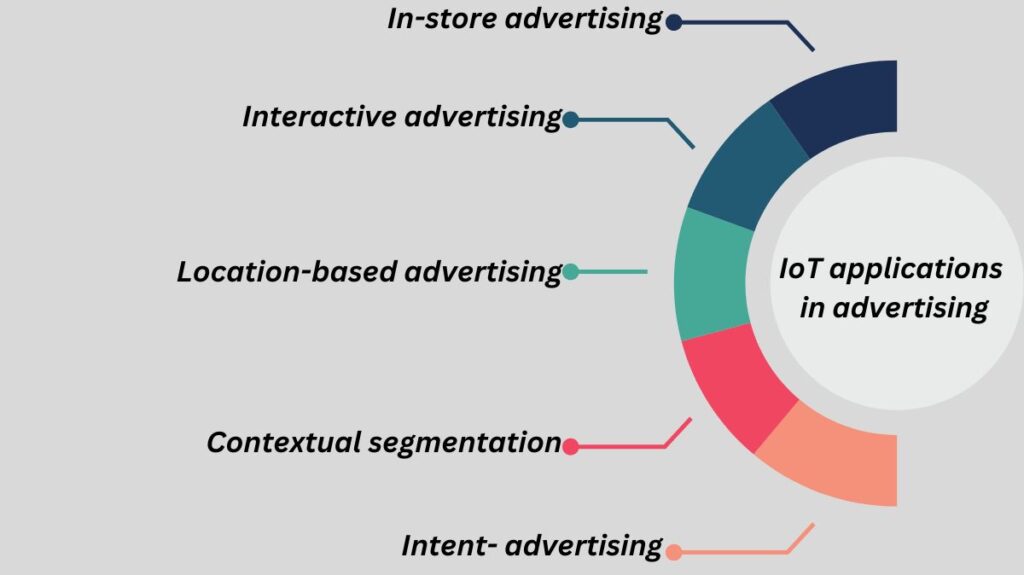What is IoT in advertising?
Start with explaining smart IoT in advertising and how it differs from traditional advertising.
IoT technology enables us to connect disparate physical things into a single network, as you may already be aware. These networks may consist of a variety of smart devices with sensors that are designed to collect data in real time. These capabilities enable IoT devices to gather a wealth of important marketing data needed for tailored ads, which are anticipated to revolutionise the consumer experience.
What data does marketing need in order to create consumer-specific messages? Typically, this includes data about consumer behaviour, interests, preferences, purchasing trends, search history, etc. And that’s precisely what Internet of Things devices can gather and compile to aid in the creation of a successful marketing plan.
IoT in Advertising applications

As previously said, the primary function of the Internet of Things in advertising is the real-time data collection capabilities of smart devices, which can assist improve the effectiveness of advertisements and, in turn, enable marketers to make better use of their advertising resources.
Let’s take a closer look at certain usage cases.
In-store advertising
Smart technology refers to real-time smartphone ads, not supermarket banners or brochures. Small transmitters called beacons use Bluetooth to broadcast signals to nearby devices.
Beacons are able to identify which products consumers find appealing and which they are most likely to buy. An IoT app can display comparable or related products based on this data. Sales and revenue can be greatly increased in this way.
Interactive advertising
Instead of using traditional one-way advertising, brands and consumers may now communicate in a dialogue format with the Internet of Things. Interactive advertisements are designed to entice viewers to take action and complete tasks in order to obtain observable outcomes, such as entering a brand lottery or obtaining additional product information.
Interactive advertising does not involve much effort; rather, it presume that consumers will take the initiative. Making and sending a real-time snapshot or scanning a QR code are excellent examples of this type of engagement. Since consumer interaction always has a favourable effect on purchase decisions, it is anticipated that these solutions would significantly increase the efficacy of marketing initiatives.
Location-based advertising
Combining IoT and GPS technology in advertising can increase the efficacy of all marketing initiatives. The location of both persons and items can be tracked using such methods. Brands are able to provide highly customised ads based on this data.
For instance, an IoT app may display a list of ongoing specials to a user when it recognises that the user is close to a supermarket. Restaurants can use the same method to send users who are in the vicinity of their location the menu for the day.
Contextual segmentation
The increasing number of people using IoT-enabled devices makes it possible to collect and analyse useful data about the habits and behaviour of customers. Advertisers can send each user contextual, targeted messages with the aid of this data. Google Search Ads is a prime example. Google Ads will begin displaying appropriate offers to users based on their location and needs when they are searching for certain goods or services.
Intent- advertising
A marketing strategy that involves advertising a good or service based on consumers’ intentions to purchase it is known as intent marketing. To put it another way, intent marketing involves examining consumer behaviour and attempting to sway individuals who exhibit certain indications of being prepared to buy.
Segmenting customers based on their brand interest is essential for intent-based advertising. IoT devices may gather the necessary data, such how long customers spend near particular items in stores or what kinds of products catch their eye via a shopping app. Brands may use all of this information to further refine their advertising strategy, provide more useful advertisements, and completely transform the consumer experience.
Generally speaking, it can state that some IoT-powered tools and applications for advertising are rather comparable to software items utilised in the retail sector. The goal of both sets of solutions is to increase sales and, as a result, profitability.
Conclusion
As you can see, considering how these apps affect the success of marketing efforts, IoT in advertising sector is moving in a positive manner. The increasing need for IoT development services across different businesses and organisations can be explained by the generally observable advantages of apps driven by the Internet of Things.
IoT devices can assist firms in reaching consumers with more precisely focused advertising messages, which makes all of these efforts more realistic and maximises a business’s marketing expenditures to generate more income.
Read more on IoT Applications: Revolutionizing Smart Technologies
Read more on IoT Applications in Smart Vehicles For Better Access, Safety
Read more on IoT Applications In Agriculture: Boosting Farm Productivity
Read more on Applications of IoT in Smart Home Expanding Safety & Quality
Read more on Top IoT applications In Healthcare For Better Efficiency
Read more on Applications Of IoT In Smart Cities For Better Living
Read more on IoT Applications in Retail: Smarter Stores & Supply Chains
Read more on Applications Of IoT In Education: Smart Schools & E-Learning
Read more on Applications Of IoT In Government: Security & Public Safety
Read more on What Is Consumer IoT And Consumer IoT Applications
Read more on Applications of IoT In Manufacturing And Key Benefits
Read more on IoT Marketing Key Components, Benefits And Applications
